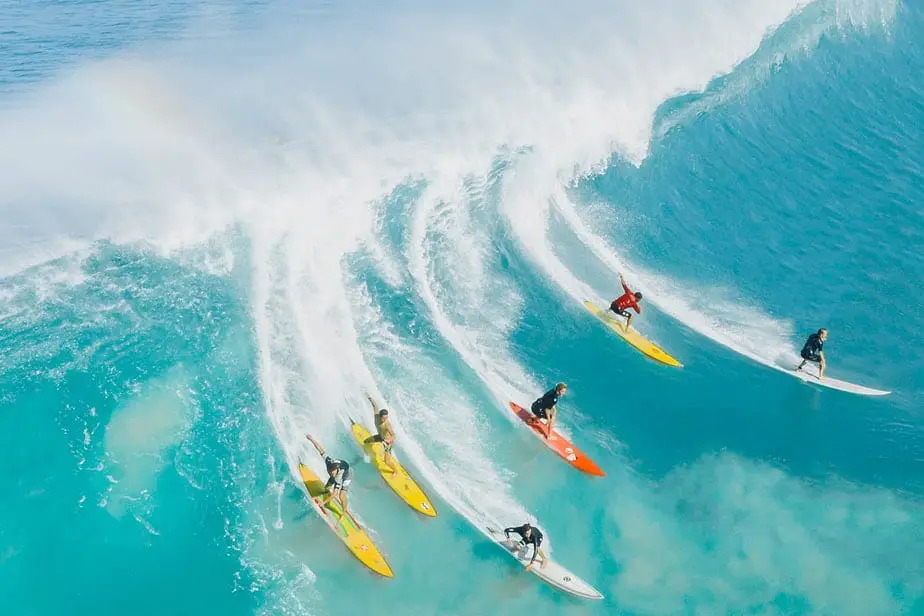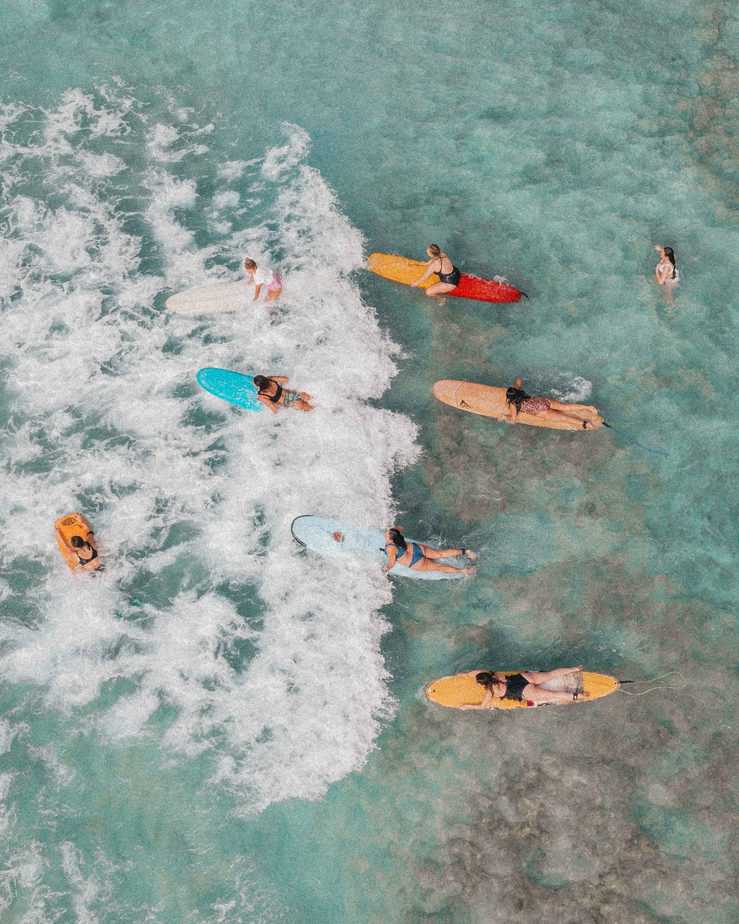You may have been told that you shouldn’t wear a bright colored wetsuit or have a bright colored surfboard, specifically the color yellow, because it attracts sharks. While there is a kernel of truth to that statement, it doesn’t tell the full story.
This belief came about due to research conducted by the US Navy in the 70s where they found that sharks seem most attracted to the color yellow (they wanted to find out which colors they should use on life jackets). At some point, someone jokingly referred to yellow as “yum, yum, yellow” and it stuck for decades and persists even now.
Then, in 2015, yum yum yellow appeared to be all but confirmed during a heart-stopping moment on live television when surfing legend Mick Fanning was attacked by a Great White Shark. He escaped physically unharmed, but his yellow-bottomed surfboard was ripped to shreds.
Fanning himself was convinced that it was his yellow surfboard that caused the attack, and he has since ditched all of his yellow surfboards.
While it seems like this is an open-and-shut case, there’s more to the story than simply “sharks like to chomp down on yellow objects.” We now know that sharks are actually colorblind and what they are noticing is the contrast of certain colors against the dark background of the ocean.
In this article, we will discuss why sharks seem attracted to the color yellow, how sharks even perceive color, if they are attracted to any other colors, and what colors you should avoid when surfing.
Is “yum, yum, yellow” a myth?

We may not know exactly what sharks see, however we do have an idea of how their eyes work compared to our own.
A little bit of context: human eyes have three cone photoreceptors in the retina that are sensitive to blue, green, and red light respectively. Together, they help us perceive color as we know it.
However, recent research on what sharks can see conducted by Hart et al has found that sharks only have a single cone type in their retinas. The assumption then is that sharks don’t have color vision, and are in fact color blind.
This flies in the face of years of anecdotes and biases that claim that sharks can perceive color and even seem to have a preference for some, especially the color yellow.
The leading theory now is that what sharks have been perceiving all this time was the contrast of certain colors against the background, not the actual colors.
According to this theory, bright colors like yellow and orange have a high contrast against the dark blue ocean backdrop, and darker colors like black and blue can actually serve as camouflage.
Thus, a yellow surfboard or wetsuit would make you stand out in the water more. Yellow doesn’t necessarily send a signal to all sharks to attack, but they may be curious and approach. This can indirectly lead to higher incidences of shark attacks depending on how the interaction goes from there.
What colors attract sharks?

Knowing what we know now about how sharks see, we know that bright colors are the more likely to attract sharks. What appears to stand out most to them are yellow and orange. However, any color that contrasts with the environment is likely to draw a shark’s attention.
If you’re afraid of sharks, you can use this knowledge to your advantage by avoiding using any gear with bright colors.
We have to preface what we are about to say next with this: shark attacks are extremely rare considering how many people surf every year, though surfers are more likely to be attacked by a shark compared to a scuba diver. Statistically, you can wear whatever you want and still not be attacked by a shark.
However, if you’re a thrillseeker who is looking to attract sharks for an adrenaline-fueled encounter, then by all means, wear yellow and orange.
As an aside, you might have realized that many life vests are brightly-colored. That’s because bright colors are also visible to us humans, and the safety benefits that being highly visible provides outweighs any risks of a shark attack.
What colors should you wear to avoid sharks?

The vast majority of shark attacks are done by tiger sharks and bull sharks, which tend to swim in shallow waters and are aggressive.
However, they seem to completely ignore muted colors like black and blue. This supports the theory that sharks notice contrasts in color, and darker colors help camouflage you with the environment.
Thankfully, the vast majority of wetsuits are black in the first place which is not a coincidence – it has camouflaging benefits. All the anecdotes of black wetsuits making you look like a delicious seal to a shark is just a myth.
There are many reasons why a shark might be attracted to a surfer even if they aren’t wearing a colored wetsuit.
For instance, your surfboard could have a yellow or other bright-colored design on the bottom. You might be splashing about or wearing reflective jewelry which can cause a shark to mistake you for a fish thrashing about that is reflecting the sunlight off its scales.
While we are debunking myths, we might as well debunk another one: sharks are not attracted to human blood or body waste. If you are bleeding due to an injury or if you are menstruating, you will not be sending sharks into a feeding frenzy.
Sharks are specifically attracted to fish blood and they couldn’t care less about human blood. We are not their usual prey, and many sharks actually back off from attacking a human once they realize they’ve made a mistake (unfortunately, usually a single bite is fatal).
Do stripes repel sharks?
Some wetsuits and surfboards have been advertised to feature patterns that repel sharks.
We know that sharks take notice of high contrasts, so some wetsuits and surfboards purposely feature black and white stripes as part of their design.
The theory is that black and white stripes imitate the black and white stripes of venomous prey such as sea snakes which may give sharks pause.
Some experiments, such as in this video, seem to support the theory that stripes deter sharks.
However, there isn’t a large enough sample size and any results are therefore inconclusive. It might all be marketing hype to justify a higher price, it might not, the choice is up to you.


